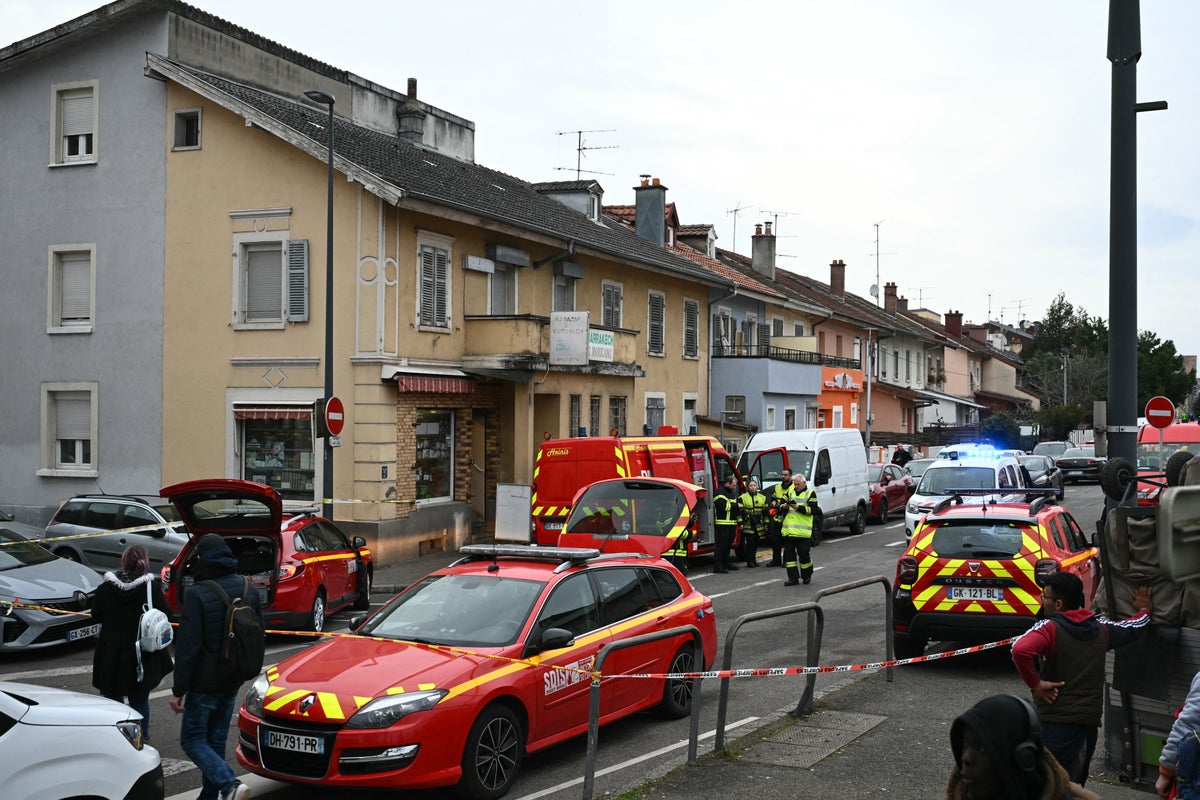A Victorian map could hold the answers to the exact cause of the two sinkholes that opened up to swallow a quiet Surrey village’s high street.
The crater first appeared in Godstone High Street on Monday with locals woken late at night and told to “get out as quickly as possible” over fears of a gas explosion.
A major incident was declared with 30 properties evacuated before a second void split open another part of the road a day later.
Almost a week on and experts are scrambling to find the cause of the collapse as locals, who have no idea when they might be able to return to their homes, fear this sinkhole could be just the first sign of trouble for Godstone.
One expert has suggested the crater may be related to the collapse of a nearby abandoned sand mine.
London’s insatiable demand for sand for building during the industrial revolution led to quarries being dug out underneath the Surrey village with the material said to have been used in the 18th century for the flooring of Westminster Hall.
British Geological Survey (BGS) regional geologist for South East England, Andrew Farrant explained how maps of the area published in 1872, appear to show an entrance to an old sand mine very close to the “sinkhole”, which could be related to the ground collapse.
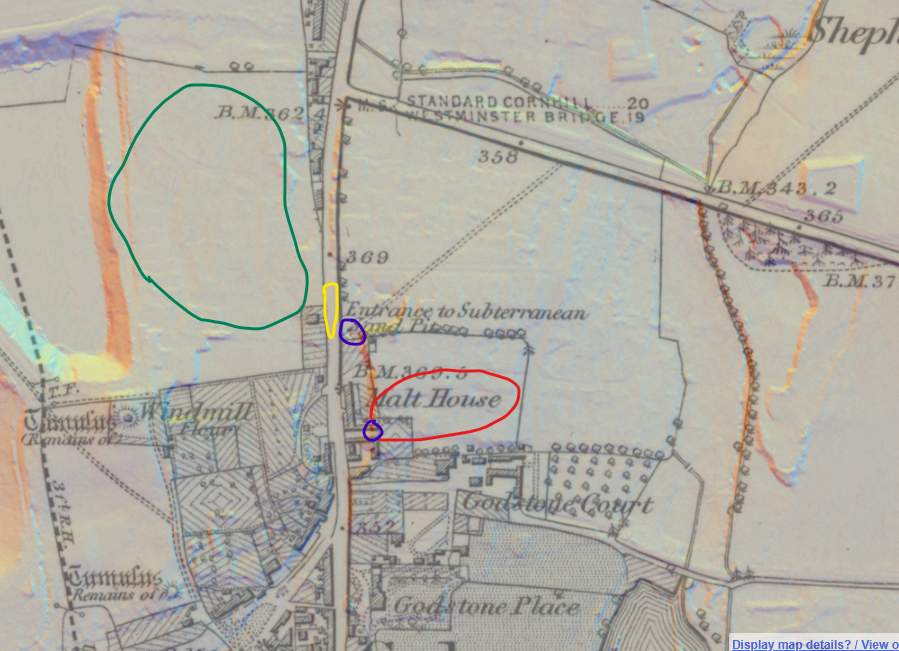
There are also two old mines nearby with entrances on the east side of the road south of the collapse site. The entrance to the nearest and largest of these is in an old builder’s yard and extends around 100m to the east under allotments.
“It is possible other unrecorded sand mines occur in this area,” Andrew Farrant said.
“It is also possible that a leaking pipe has weakened the rock and led to the failure of a putative mine, assuming it exists and extended under the road.
“Equally, it is possible that gradual failure of a mine roof caused the water main to fail, triggering further subsidence.”
A dense cave network filled with subterranean passages thought to be about eight miles in length, also lies just 80-200ft below the surface, it has been reported. And the Home Office even looked into protecting Londoners from the horrors of the Blitz in the caves under Godstone, according to a local history website.
A Surrey Mirror news cutting from November 1879, dug up by local caver Peter Burgess, also reports that a horse-drawn van trying to connect residents to the water supply was swallowed when a large hole appeared in the same stretch of Godstone High Street. Fortunately both survived after the water flow was shut off just before it reached the horse’s head.
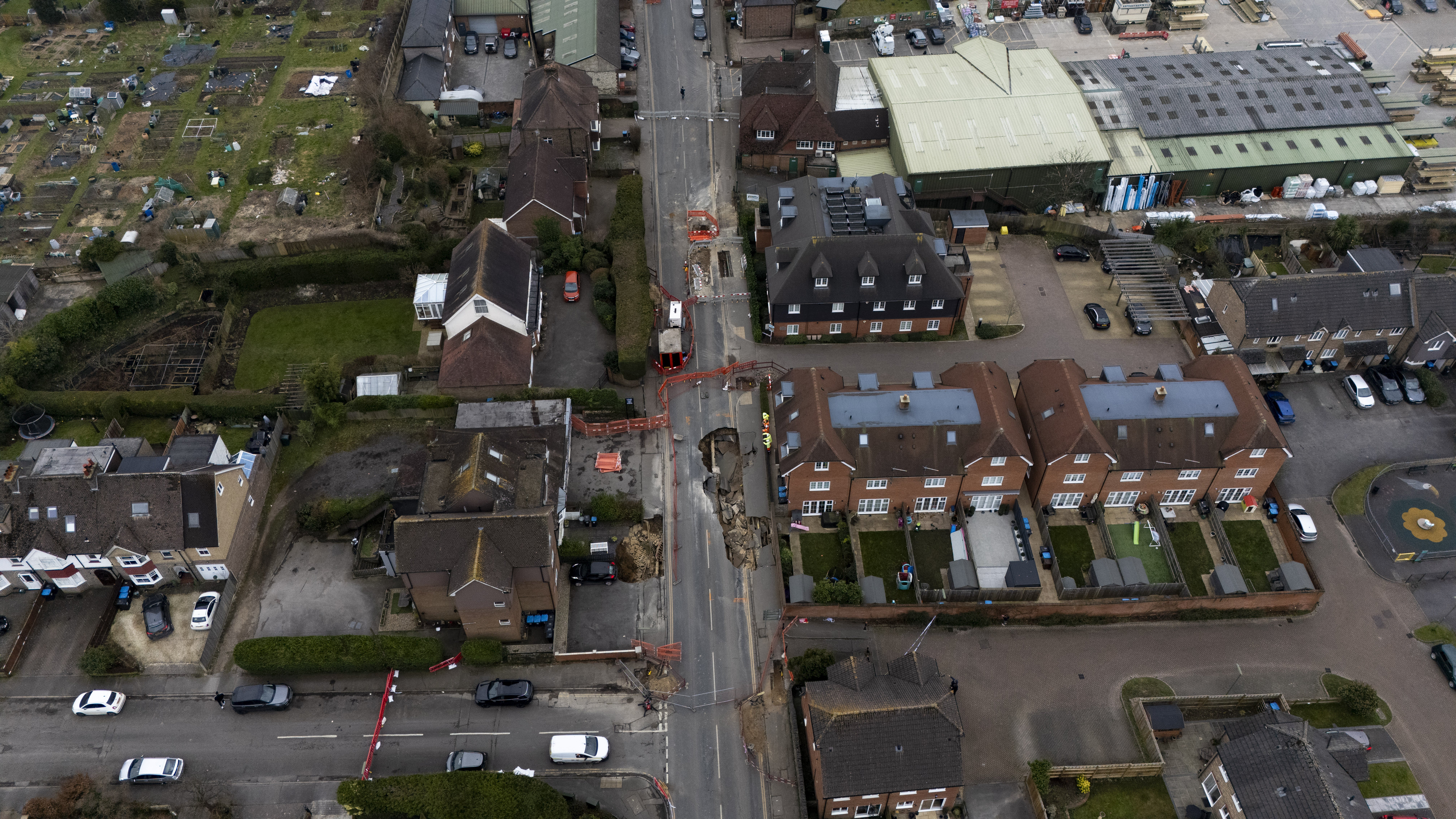
Back to the present day and Sarah Jones told The Independent she was visiting the site as her daughter was about to exchange contracts and ahead of a big move to Godstone.
“It’s a gorgeous village but what a great time to buy”, she laughed.
“We saw all the news and had to come see and check it out. Whether we call it [the sale] off altogether is a different story. Would they be able to sell to anyone else now? It’s going to be a problem. We’re pushing for a reduction.”
One grandfather, defying the council’s evacuation orders, told The Independent: “It’s all the Londoners’ fault really.
“For 400 years they have taken the rock out of here.
“Most of London is built on Godstone stone if you look it up. All their lovely sandstone buildings are from here. That’s the truth of the matter.
“We gave them all our nice sand and they just give us s*** back for the dump. That’s what they have done.”
Shane Fry, who runs garage DD Services next to the sinkhole is fighting to keep his business open as the now-eerily quiet high street has promoted Godstone locals to nickname the village ‘Godshole’.
Recalling the moment it opened up on Monday night he said: “I was in the local pub playing with our darts team. We had just left and a couple of lads were walking home and saw the start of it happening.
“They were a bit fascinated more than worried at that point.”
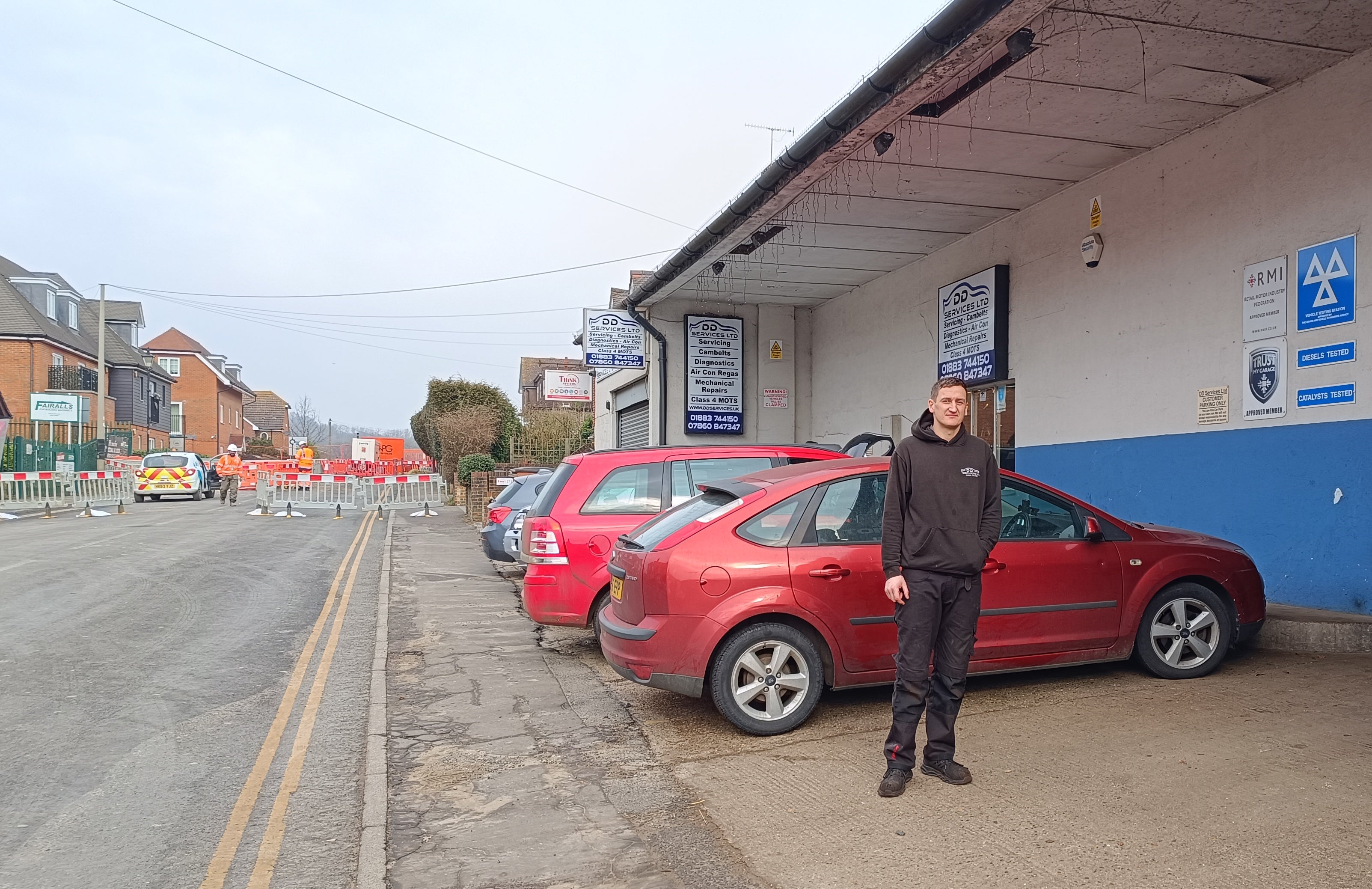
As time wears on business owners’ anxiety only increases as the usually bustling high street has ground to a halt with fears the road could be shut for up to six months – which could prove devastating.
“The road needs to be closed for everyone’s safety but it’s going to have a detrimental effect for a long time”, Mr Fry said.
“I need to ensure that my customers stay with me. It’s hopefully not going to get worse.”
He added: “It’s a great village, a great community, a lot of locals have proven that by supporting everyone who needs it. Godstone is a great place to live and work, hopefully we can stay open. But I don’t think we’re going to get any answers any time soon.”
Roger Morel, who has lived in Goldstone for 22 years and woke up to discover his house had no water pressure after the sinkhole appeared, said the problems should have been foreseen.
“There have been problems with the water main forever. They are all Victorian and you have the caves underneath here so it has probably washed all the ground out and it’s all sunk down.

“Now we get loads of heavy lorries bulldozing through this high street, some parts are 15th Century and it wasn’t designed for these huge vehicles.
“People are just worried about when the next sinkhole is going to come. They’ve had leaks before coming out of the tarmac.
“I would love to see a 7-tonne weight limit put in to stop the lorries, some must be 30 tonnes they are huge and it’s lucky no-one was hurt.”
When The Independent visited, Surrey council staff were telling locals it was still too dangerous to move their cars back on their driveways after one was left teetering on the edge of one of the craters.
John Thomas, 54, who lives on the edge of a cordon surrounding the vast cavities said there were caves underneath his allotment.
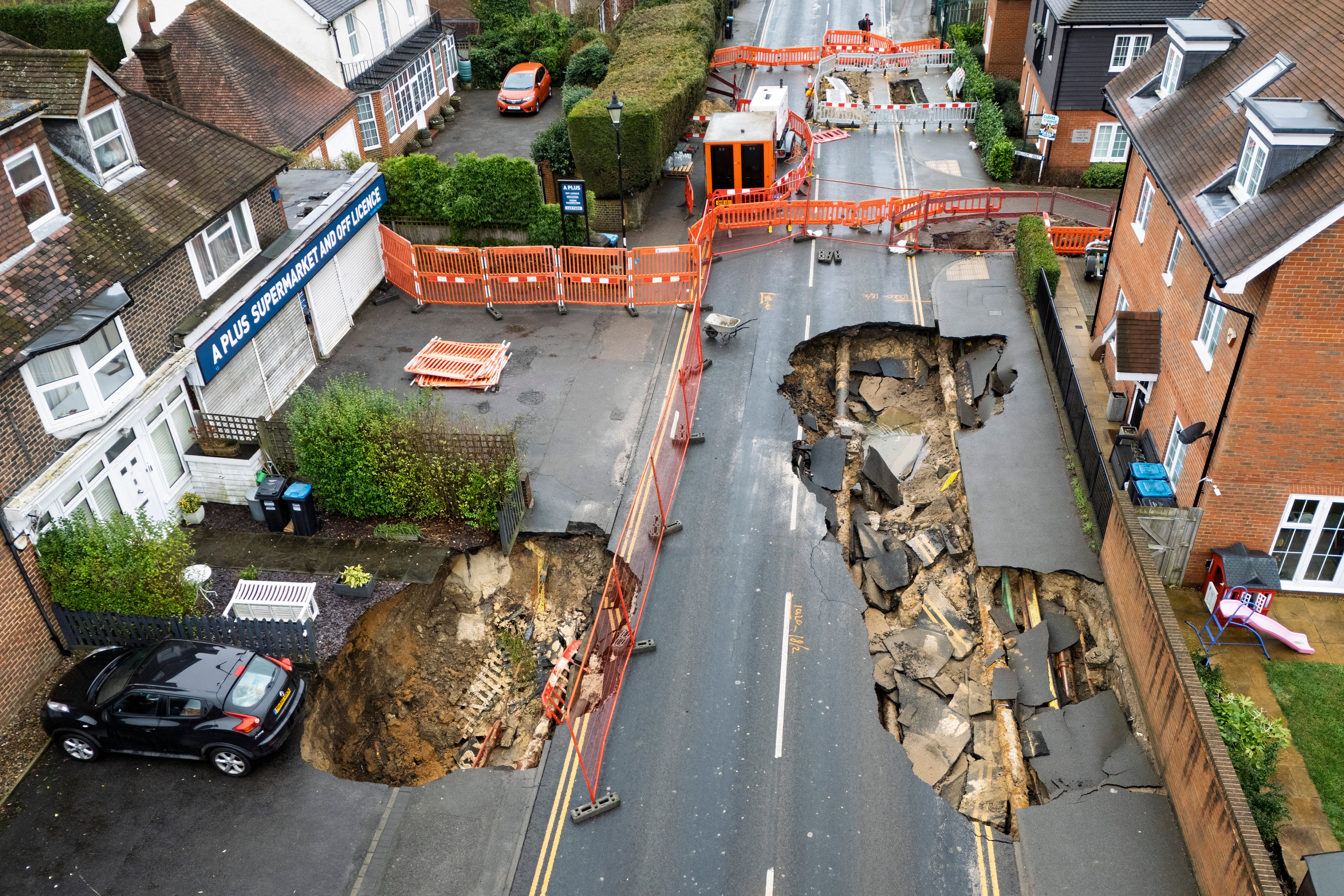
He said: “It’s only 50m away so it is as close as you want it to get. One engineer snuck us in to have a look. We hadn’t realised there were two holes forming.
“You can see under the road. It’s like one massive hole with a road going over the top of it. There is nothing to support it at all.”
He added: “We know there are lots of caves underneath us – so it is a bit worrying. All the kids want to see what is going on but they aren’t letting anyone close.”
Investigations are continuing to determine the exact cause of the sinkhole and to establish the full extent of the damage.
Once the area is stabilised, a repair and reconstruction plan will be developed, Tandridge District Council said.
Five families are still being supported with overnight accommodation, with one father even forced to sleep in his car, according to locals.
Commenting on the Godstone void, Mainmark UK commercial and infrastructure lead David Hedley warned that the impacts of climate change could lead to more “devastating” subsidence events and sinkholes.
“As bouts of extreme weather – from washouts to periods of draught – become more prominent with climate change, I would expect these to trigger more ground instability events in years to come,” he told Ground Engineering.
“In the last year alone, sinkholes have appeared in Wimbledon, Merthyr Tydfil and Nottinghamshire, resulting in disruption and costly repairs. Postcodes which lie on soft clay soil are also vulnerable, which covers a lot of the South East.”
